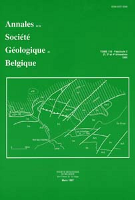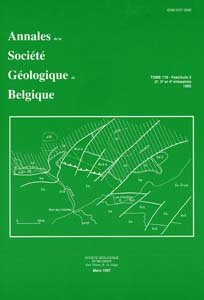- Home
- Volume 114 (1991)
- Fascicule 1 (Proceedings of the International Meet...
- The concealed crystalline basement in Belgium and the "Brabantia" microplate concept : constraints from the Caledonian magmatic and sedimentary rocks
View(s): 1365 (14 ULiège)
Download(s): 2096 (12 ULiège)
The concealed crystalline basement in Belgium and the "Brabantia" microplate concept : constraints from the Caledonian magmatic and sedimentary rocks

Abstract
The presence of a Precambrian crystalline basement beneath the Caledonian sedimentary segment of the Brabant Massif is inferred from several petrological features of the Caledonian magmatic rocks : 1) the occurrence of some gneissic xenoliths; 2) the discovery of old (possibly Archean) inherited zircons; 3) the Sr-Nd isotopic features of the liquid lines of descent (+ 0.3 < εtNd < - 4.8; - 22 < εtSr < + 59) that imply a two-stage crustal contamination with Rb-depleted and Rb-enriched rocks. They constrain a Brabant basement at least partly older than 1.8 Ga that could extend eastward below the Ardennes Massifs and the Rhenish Massif. The isotopic features of both groups of contaminants are investigated through assimilation-fractional crystallization (AFC) calculations. An important conclusion of these models is the probable occurrence of old Rb-depleted granulitic components in the Brabant crystalline basement. This finding coupled to the seismic unreflectivity of the Brabant crust underscores this basement as an important nucleus in the genesis of the Early Palaeozoic European crust. Some information on the nature of the surface of this basement is also provided by the study of the lithic fragments in the Early Cambrian sediments of the Brabant Massif and the geochemical and Nd isotopic features of the Cambrian-Ordovician fine-grained sediments from the Brabant and Stavelot Massifs. They clearly demonstrate that this surface is made up of two main groups of Precambrian rocks, some juvenile (mantle-derived) late Proterozoic (t < 0.9 Ga) basic intraplate tholeiitic metavolcanites overlying some older (TDM > 1.9 Ga) felsic crystalline rocks.
The strong similarity between the εtNd-t paths of the Caledonian sedimentary masses from Belgium, southern Britain, Brittany and southern Nova Scotia reveals that all these sediments result from mixtures between similar Late Proterozoic juvenile source units, during the Cambrian, that graded into mature, Early Proterozoic or Archean sources, in the Ordovician. The apparent lack of Sveconorwegian components is at variance with a Baltic Shield provenance while the ubiquitous Pan-African component favours a Gondwana derivation. The various Early Palaeozoic plate tectonic configurations (Baltica Peninsula, Cadomia, Armorica and Avalonia concepts) are reviewed in the light of these new data and the geological constraints from the Belgian Caledonides. These data strongly support the existence of an Ordovician Tornquist Ocean separating Baltica from a Gondwana-derived microplate including most of southern Britain and Belgium that is defined here as the "Brabantia" microplate.
To cite this article
About: Luc André
Musée royal de l'Afrique centrale, Leuvensesteenweg, 13, B-3080 Tervuren, Belgium






